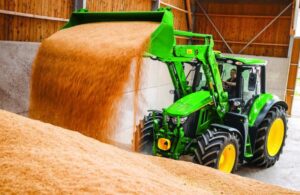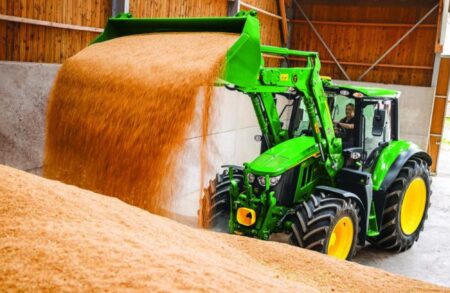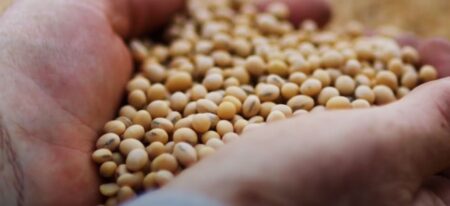As corn and soybeans progress into reproductive stages, midseason scouting is not just a box to check — it’s a key driver of yield protection and return on investment. Timely in-field observation helps identify weeds that escaped early control, diseases emerging under humid conditions, and insect threats that can damage ears, pods, and roots.
Watch for Weed Escapes
Now is a good time to scout for weed escapes, even though postharvest is the next major control window. Mapping and noting current weed hotspots will help guide next season’s weed management strategy. “Go out and scout those fields,” said Stevan Knezevic, weed management specialist at the University of Nebraska. “Look for survivors, and look for regrowth because that regrowth can most likely carry a resistance gene, so you will have problems next year.”
Control weeds in areas like ditch banks and roadsides to prevent future seed spread, recommended Kurt Maertens, technical agronomist for BASF. If post programs are stopping weeds in the row but ignoring edges, the seed bank persists, Maertens said. “Weeds that go to seed on the margins of fields can be pulled through the combine and distributed across the whole field,” he explained.
Natalina Sents Bausch
Mechanical control, such as mowing, hand-roguing, or even targeted spot-spraying 2,4-D after brown silk in corn, can prevent seed from creeping in from the margins. “I prefer 2,4-D amine plus crop oil for edge cleanup,” Maertens said, “because it’s less volatile than ester formulations.”
When assessing weed escapes, Purdue Extension recommends asking key questions to identify the cause, such as herbicide resistance, poor coverage, or seed spread by equipment.
With today’s drone and camera technology, it is often possible to identify weeds from aerial photos, especially if the drone flies at low altitude. Harvest offers another opportunity to identify weed escapes.
Corn and Soybean Diseases Showing Up Now
Foliar diseases are also a concern, particularly under humid, wet conditions. In corn, tar spot, gray leaf spot, and southern rust are some of the major threats, with symptoms often beginning on lower or mid-canopy leaves. In soybeans, diseases like frogeye leaf spot, white mold, and sudden death syndrome can develop rapidly, especially in tight canopies with poor airflow. Scouting before tassel in corn and from early bloom to R3 in soybeans is critical for making fungicide decisions. “Once symptoms are visible on imagery, it may already be too late to recover yield,” cautioned Andrew Penney, Bayer’s precision agronomy lead. He encourages a proactive approach using tools like Crop Protection Network’s crop disease forecasting tool alongside boots-on-the-ground scouting to guide fungicide application.
Courtesy of University of Kentucky
“It can be daunting to think about looking at every acre in every field multiple times a year, but it’s the best way to know what’s present in the field at what levels, and to know if you need to make a management decision about it,” said Kiersten Wise, a plant pathologist at the University of Kentucky.
To aid in prioritization and decision-making, Wise recommends using disease-tracking maps along with local weather and crop progress reports. When considering fungicide applications, farmers should weigh both disease presence and product effectiveness. The Crop Protection Network (CPN) offers several science-based resources to support these decisions. Their widely used Fungicide Efficacy Tables summarize multi-state trial data on how well common fungicides control specific diseases, including tar spot, gray leaf spot, frogeye leaf spot, and more. These tables are updated annually and help growers compare products side-by-side to make more informed choices.
Courtesy of Michigan State University
For corn producers, the CPN also offers a fungicide return on investment (ROI) calculator backed by university trial data. For example, with an expected yield of 207 bushels per acre, the probability of breaking even after a fungicide application was similar for high (greater than 5%) and low (1%) disease severity, ranging from 45%–53%.
“It’s a good way to assess what the potential profitability would be for an individual farmer based on their expected yield and sale price, and what they’re going to pay for that product,” Wise said.
What Insects to Scout for in July and August
Insect pressure ramps up during the midseason window, especially as crops enter reproductive stages.
Corn Rootworm
For corn, rootworm remains the dominant threat, but it’s far from the only one. According to Andrew Penney, Bayer’s precision agronomy lead, rootworm behavior has become increasingly unpredictable due to variants like the western corn rootworm, which lays eggs in soybean fields, and the northern corn rootworm, which can enter extended diapause.
Syngenta
“Even in rotated acres, we now have to ask if rootworm is still a concern,” Penney said. Bayer’s “Rootworm Watch” kits, which include sticky traps, can help monitor adult beetles around VT to R1 stages. He recommends root digs beginning once the soil accumulates 650–700 GDUs which roughly coincides with lightning bug emergence.
Penney also emphasized the importance of using the nodal injury scale when assessing corn root digs, with a threshold of 0.5 (half a node fed) as the tipping point for potential yield loss. If consistent feeding above this level is observed, growers may need to escalate trait packages or consider insecticide interventions. Still, he cautions against overreliance on a single trait, even RNAi technology, stressing the importance of diversified management strategies.
Bayer Crop Sciences
Rootworm beetles can cause yield loss if emergence occurs when corn is silking, and therefore, this is a critical time period to scout fields,” according to a report by Iowa State entomologists Erin Hodgson and Aaron Gassman. “Adults are strongly attracted to silks and will mass on plants to feed and mate. Adults that trim silks during pollen shed will interfere with optimal pollination.”
A couple of conditions can add to the potential for rootworm damage, the entomologists say. First, if your corn’s under some drought stress, those plants won’t be able to withstand as many adult rootworms, especially when they’re pollinating. A plant under ideal conditions can tolerate up to 15 adult corn rootworm beetles while one under drought stress can only take on five.
Bayer Crop Sciences
In addition, fields that were planted later in spring are more susceptible to economic rootworm damage than those planted earlier.
“Late-planted fields or late-flowering hybrids are generally attractive to adult corn rootworm. Silks will still be developing in these fields when older fields have brown or drying silks,” Hodgson and Gassmann said. “Adults may migrate and aggregate in these later-maturing fields.”
If you’ve got an infestation on your hands, consider a quick foliar insecticide treatment. “With adult corn rootworm becoming active during silking this year, we highly recommend keeping an eye on fields in order to protect yield. A foliar insecticide may be warranted if there are five or more beetles per plant, silks have been clipped to less than one-half inch of the ear tip, and pollination is not complete,” said Hodgson and Gassmann. “Also take into consideration other insects that may be feeding on the silks at the same time (e.g., Japanese beetle).”
Western bean cutworm
Western bean cutworm is another pest to watch closely in July. In a recent Michigan State University webinar, Chris DiFonzo, extension entomologist, reported that flight is underway across the Great Lakes region. “If you’re in corn, you’re looking for the peak catch to start scouting,” she advised. For dry bean growers, she recommends waiting until trap counts reach 120–150 before pulling the trigger on sprays. Corn growers should check pre-tassel fields for egg masses soon after peak moth flight, as control is most effective before larvae enter protected whorls.
Soybean Aphids
Soybean aphids are also present this year, though widespread outbreaks haven’t occurred in the Eastern Corn Belt since 2007, said DiFonzo. Thanks to natural populations of predators, many aphids are already parasitized by the time they’re detected. “Growers in the Midwest have done an awesome job of not spraying when they don’t need to,” DiFonzo said. She strongly recommends holding to the economic threshold of 250 aphids per plant, rather than applying preventive insecticides, which would increase the risk for aphids to develop resistance, as has happened in some of the western Plains states. “The people who spray for no reason have burned through their pyrethroids. We don’t want to be them.”
Gil Gullickson
Defoliation Thresholds in Soybean
When it comes to defoliation from pests like Japanese and bean leaf beetles, updated research funded by the North Central Soybean Research Program has recalibrated economic thresholds. The revised thresholds for defoliation in soybean are:
- 30% during vegetative stages (V1–R2)
- 10% during peak reproductive stages (R3–R5)
- 15% at R6
DiFonzo noted that most defoliation is patchy and rarely reaches these levels when scouting is done correctly.
John Obermeyer, Purdue Univeristy
DiFonzo reminded farmers to watch for first-generation corn borers, particularly in non-Bt or seed production corn. As always, field edges and areas with cover crops or early-season weeds may host higher populations.
When it comes to scouting for insects and diseases, Penney offered some advice: “The key is to be efficient with your time,”he said. “Scout hybrids that are most susceptible first, and know what’s moving in your area.”
Digital Tools Complement But Don’t Replace
Technology can aid scouting efforts. NDVI imagery, drone flights, and thermal imaging can flag variability that may signal disease or stress. However, Penney warned that by the time visible symptoms show up on imagery, yield may already be impacted. He prefers a proactive strategy: use digital tools for planning, but rely on human observation to make timely decisions. “Be ahead of it,” he said. “If you’re reacting to visible symptoms, you’re already behind.”
The Power of Proactive Observation
Despite trait advancements and digital tools, Penney believes nothing replaces the importance of observation and pattern recognition. “Mother Nature always wins,” he said. “We need to keep evolving our technology, but we also have to be out in the field, scouting and learning. That’s how we know when it’s time to shift to something new.”



:max_bytes(150000):strip_icc()/Markets-9-Corn-down-wheat-down-5-255020c945814214a487a11b89b5066b.jpeg)
:max_bytes(150000):strip_icc()/SoybeanRedCrownRotSPorter-a25a83ece6b54909b3e6ba0d997bd49c.jpg)


:max_bytes(150000):strip_icc()/Kevin20Matthews20Disease20Corn-ce115e88b4b04f5e99cd645345682b48.png)


:max_bytes(150000):strip_icc()/Cotton-Harvest-Matt-Miles-88f0df3cb0b84cc2aacfe15e4c15bda8.jpeg)
:max_bytes(150000):strip_icc()/IMG_7936-c12c642ad0064146a4aecfc1a60502a3.jpeg)